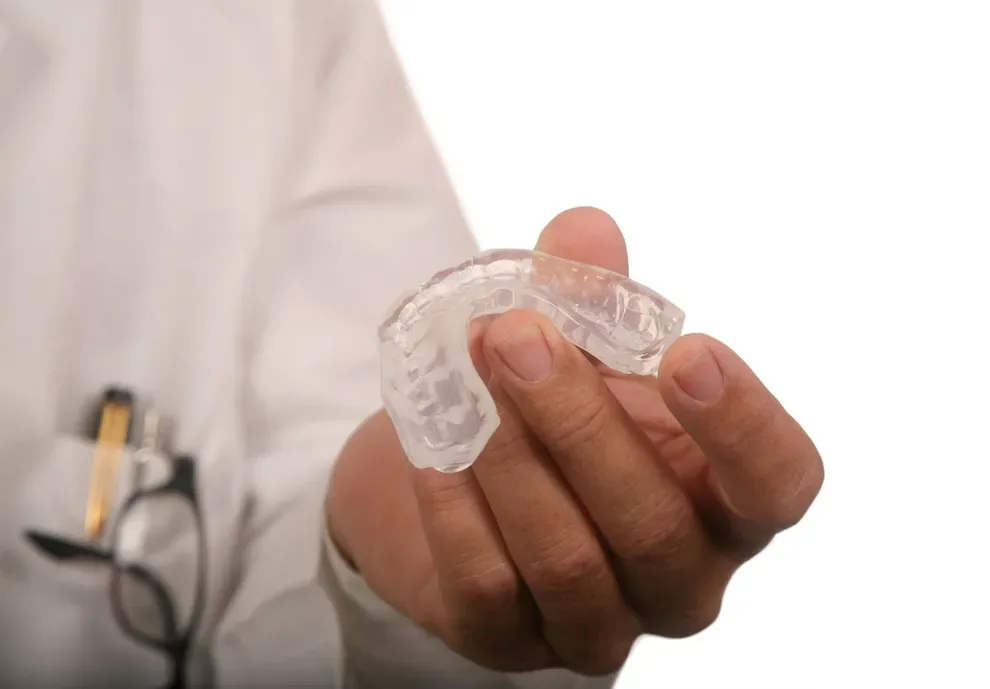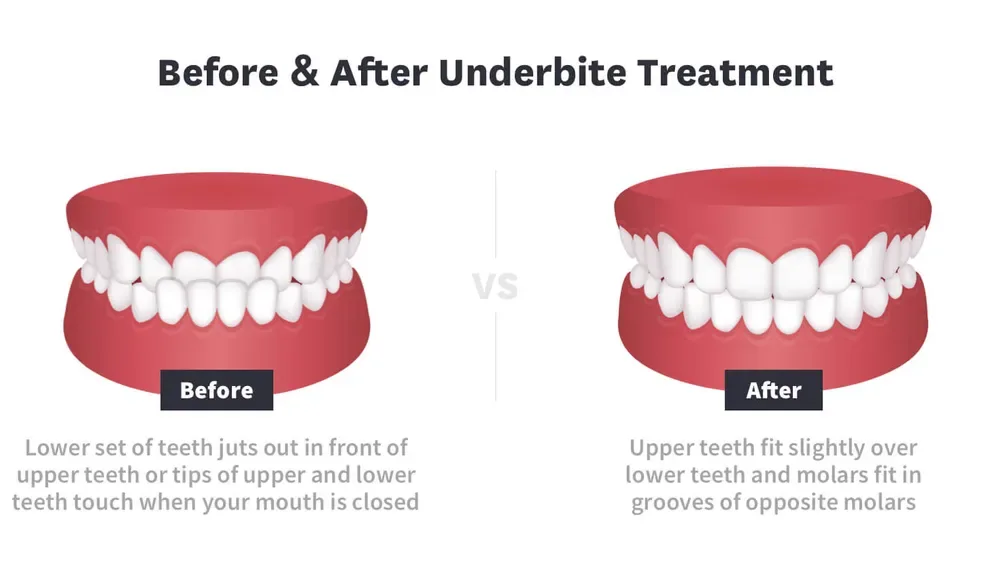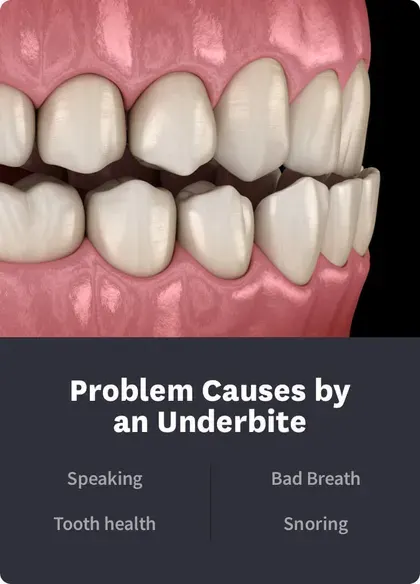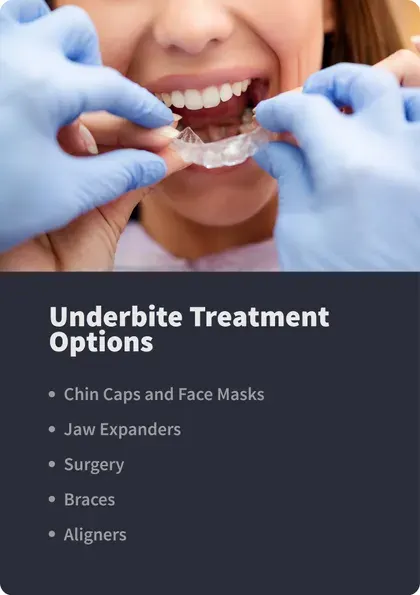Underbite Causes, Treatment & Remedies.

Table of Contents
- Causes
- Complications
- Treatment Options
- How Aligners Help
- More Extensive Changes
- When Aligners Are the Best Choice
- References
When you close your mouth and your teeth click together, the lower set juts out in front of the uppers. This is an underbite.
Some people have a very mild version of an underbite, where the tips of their teeth touch when their mouths are closed. Others have severe underbite issues, where their incisors never meet at all.
You could choose to live with an underbite. Plenty of people, including many prominent public figures, do just that.
But an untreated underbite can cause you pain, embarrassment, or eating difficulties.
Treatment options range from headgear and braces to aligners and surgery. The choice that's right for you depends on the significance of your bite problem and the health of your mouth.

What Causes an Underbite?
If you flip through family albums and see many people with jutting lower teeth, you're likely to face the same problem. Many cases of underbite are caused by genetics. But choices you made when you were younger could make the situation worse.
Experts explain that a combination of nature and nurture is behind most underbite cases. You may have a genetic propensity for the problem, and you compound it by:
Thumb sucking. Most babies enjoy sucking on their fingers, thumbs, and toes. The habit often fades as babies develop a taste for firm foods. But if you keep sucking your thumb as the years pass, you could alter your jaw's growth pattern.
Tongue thrusting. Your tongue is an incredibly strong muscle. While most people allow it to lightly tap against their teeth, if you push on your teeth with great force, you could change how your jaw grows.
Pacifier use. If your parents gave you a pacifier to use while you were young and teething, it could blunt or block jaw growth. Sucking on a device like this puts immense pressure on muscles, and they can alter the final shape of your jaw.
Some babies are born with jaws that jut forward. Their habits in youth can make the issue more pronounced. But some babies born with meshing jaws develop an underbite as they grow.
Problems Caused by an Underbite
Every jaw looks different, and an underbite isn't inherently ugly or bad. But sometimes, the configuration of your teeth and jaws can lead to problems.
For example, teeth that don't mesh can cause intense pain when you bite or chew. Pressure along your jaw is unbalanced, and some of your teeth work harder than others. Sensitive pulp inside your teeth can swell in response, and the discomfort can be significant.
You might also experience problems with:

Speaking. We rely on precise movement of our jaws, teeth, and tongue to enunciate clearly. If your teeth don't meet properly, your words can sound slurred or muddy.
Tooth health. Uneven wear can cause tooth grinding, and soon, the protective enamel that covers your teeth can thin and disappear. This can lead to cavities or tooth loss.
Bad breath. It's harder to clean your teeth when your jaws and teeth hurt and don't fit together properly.
Snoring. When you sleep, your jaw position can block your airway. You may awaken at night feeling like you're not getting enough air.
Some people think an underbite is unsightly. They feel self-conscious about the way they look, and they refuse to laugh or smile in public, as they worry about teasing.
Genetics are responsible for most underbite cases, but lifestyle choices matter too; fortunately their are plenty of treatment options exist, including surgery, braces, and aligners.
6 Underbite Treatment Options

The earlier you address an underbite issue, the better. In fact, if parents work to help their children make good choices, they could limit the amount of treatment the child needs later in life.
Common underbite treatments include:
Children can benefit from these jaw-hugging devices. They limit the growth of the jaw, which can allow the child's smile to develop in an optimal manner.
A device sits on the roof of the mouth, between the teeth. It's slowly expanded, and as it gets wider, the jaw widens too. A wider upper jaw can sometimes fit over the lower jaw and prevent an underbite.
Underbite correction surgery involves detaching the jaw and removing a bit of bone. The entire jaw can then move back and nest below the upper. Recovery can take a long time, but the results are permanent.
Brackets cover upper and lower teeth, and the smile is pulled into alignment. Orthodontists can use elastic devices and headgear to help pull the lower jaw into the proper position or widen the upper jaw. People with underbites are two to three times more likely to have long treatment times compared to people without the issue.
People with mild underbites can benefit from treatment with clear aligners. The devices slide over the teeth, and they're changed periodically to push the smile into the proper position. As the front teeth widen and move forward, the lower teeth move back.
You'll need a professional's help to determine what treatment option is right for you. Some people do well with mild or moderate treatments, and others require surgery to get the results they want.
How Do Clear Aligners Fix an Underbite?
For adults, clear plastic aligners are a fantastic option to fix your underbite. However, the use of clear aligners to fix an underbite depends on the causes of the underbite.
For mild cases of slightly protruding lower teeth, an aligner alone can move your teeth, so they are slightly behind your upper teeth. However, more serious cases require a combination of jaw surgery and aligners.
More Extensive Changes
Jaw alignment surgery, tooth extraction, and palate expanders are not just used to shift lower teeth but also to change the ratio of the upper and lower jaws to one another. One of the major causes of underbites is a lower jaw that is larger than the upper jaw, so changing the upper jaw’s shape can significantly improve dental alignment.
Another common cause of underbites occurs when the lower jaw protrudes too far forward in its natural resting position. In this case, the jaw must be realigned with surgery. For children, more extensive orthodontics, like headgear, may be used.
You might still need a clear aligner for your lower teeth after surgery — not only to push them into alignment with the upper teeth, but also to ensure any other dental misalignments are corrected so your jaw is less likely to shift again. The combination of surgery and clear aligners can correct a serious underbite in about three months.
When Aligners Are the Best Choice
If you have a less complex underbite, clear aligners work wonders. They take 12 months or less to realign all your lower teeth into the proper position.
Clear aligners for at-home treatment are sent to you all at once. This is after an orthodontist has evaluated your dental needs and created a series of clear teeth aligners using your dental photos and molds, as well as the latest mapping technology.
You will receive directions on how to use the aligners, but most people wear each one for about two weeks, 22 hours per day. Correction can take several weeks to months, but it rarely takes more than a year when using only clear aligners.
